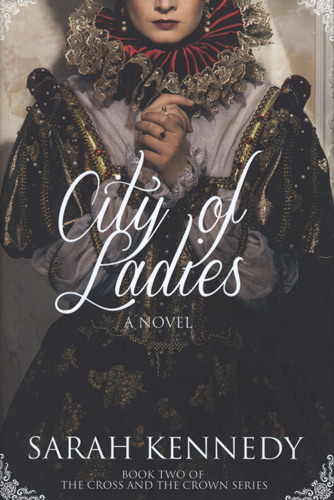City Of Ladies
Perhaps I should start by saying that City of Ladies is the second book in Sarah Kennedy’s “The Cross and the Crown” series, and I have shamefully not read the first. I started this book believing I might do its review a disservice by not reading the first installment of the series, but by chapter three or four it was clear that City of Ladies can stand on its own. The book follows recently reformed ex-nun, Catherine Havens Overton, and her life with husband William Overton. At her new estate, she has employed her former sisters and cares for them, who have nowhere else to go. When one is found dead, she fears for the safety of the rest of her ladies. But another murder and an investigation will not deter husband William from his plans to gain a place in King Henry VII’s court, in which Catherine plays a key role. With his assurance that the murderer will be found, Catherine reluctantly agrees to leave Overton House to serve Princesses Mary and Elizabeth Tudor. Perhaps I should start by saying that City of Ladies is the second book in Sarah Kennedy’s “The Cross and the Crown” series, and I have shamefully not read the first. I started this book believing I might do its review a disservice by not reading the first installment of the series, but by chapter three or four it was clear that City of Ladies can stand on its own. The book follows recently reformed ex-nun, Catherine Havens Overton, and her life with husband William Overton. At her new estate, she has employed her former sisters and cares for them, who have nowhere else to go. When one is found dead, she fears for the safety of the rest of her ladies. But another murder and an investigation will not deter husband William from his plans to gain a place in King Henry VII’s court, in which Catherine plays a key role. With his assurance that the murderer will be found, Catherine reluctantly agrees to leave Overton House to serve Princesses Mary and Elizabeth Tudor.
My first impression of City of Ladies was that Kennedy succeeded in being generally historically accurate (obviously the specific characters and their roles are fiction). In the first couple chapters, I even flipped to the back cover with the hopes that I would find out Kennedy had a degree associated with Tudor England (she has a PhD in Renaissance Literature!). Her knowledge of the era shows most convincingly in the dialogue of her characters. Phrases such as “by my troth,” “I will inquire,” “Before my churching” and so on, truly immersed me in a very real past. Also to this effect, the way in which the characters spoke to each other added that much more. Kennedy does an excellent job taking into account the relationship between characters and the difference of station between them. For example, Lady Catherine Overton’s station is high, but she and her ladies were once equals. The ladies speak to Catherine with a touch more submissiveness, as is deemed appropriate by the societal standards of the time, but they also offer her advice, ask her personal questions, and speak “out of turn”—none of which Catherine minds in the slightest. It is the mentions of politics and religion of the period which gives us readers something factual to hold on to, but the dialogue and the manner of speech make the story, and its characters make the world believable.
In terms of structure, I enjoyed the short chapters. The story felt almost like it was broken up into scenes, which made it easier to digest and internalize. For this book in particular, that was a positive stylistic choice, if for no other reason than reading a story that tries to describe the complicated religious and political relationships in the late 1400s can be taxing. Having dialogue that hasn’t been modernized adds to that. Breaking up the story into small chunks would make it easier to process for readers who are not used to reading in this era. As an added benefit due to this choice, something was always happening in each chapter. I was never bored, and found such the pacing to enhance to the book overall.
What sparked my interest in City of Ladies was the book’s description that Catherine was or would become involved in some intrigue regarding Mary and Elizabeth Tudor. During these chapters, the book captivated me entirely. My major complaint rests with how much stress was put on those chapters in the description blurb, because, truthfully, the section in which Catherine meets and serves the princesses seems to be only a break in the “real” plot of the story. The majority of the book follows a murder mystery, back at Catherine’s estate—far from the setting where the Tudor princesses are. The two plot lines are integrated in the beginning, in that the reason it takes so long to find the killer is because Catherine is called away to serve, but she isn’t away for too long. I almost wish the book was longer, to include both plot lines in their entirety, but also make the royal intrigue of the story seem worth the space it takes up on the back cover.
City of Ladies is the kind of book that takes you into its pages from the first sentence. Its essence is made of elegance, intelligence, and subtlety—the very elements that made up English high society during the reign of King Henry VII. Perhaps the plot overall wasn’t exactly what I thought I’d be reading, but it certainly was worth it.





